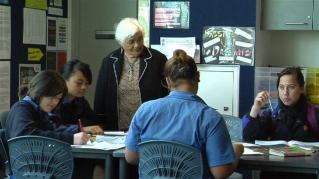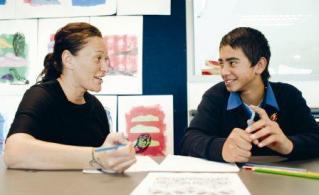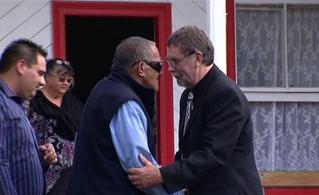Section navigation
As part of their action research for Te Kauhua phase 3, Hastings Central School investigated in what ways using aspects of tikanga, history, and local resources in a “place based” (Heretaunga district) curriculum enhanced their learning programme.
Background
Hastings Central School (HCS) is a decile two school with a roll of 181 of which 56% identify as Māori. The school has a highly transient population. It has been involved in the Te Kauhua initiative since 2006.
Research Question
In what ways does using aspects of tikanga, history, and local resources in a “place based” (Heretaunga district) curriculum enhance our learning programme?
Impetus for the initiative
The impetus for the initiative arose initially from the New Zealand Curriculum document statement: “schools need to design and shape their curriculum so that teaching and learning is meaningful and beneficial to their particular communities of students.” In seeking to meet this goal, HCS staff, whānau, and iwi agreed to work collaboratively to develop a ‘place-based’ curriculum that expressed the school’s unique character and took into account its specific location, community, resources, and student needs.
Staff and whānau perceived value in developing a curriculum that encouraged children to: understand their heritage, landscape, and culture, value it, and utilise this knowledge to grow and achieve in their world. Stakeholders sought to ascertain if a localised curriculum would facilitate productive whānau-school partnerships and impact positively on student achievement, attendance, and behaviour.
What was done?
The research was carried out in four stages. Stage one involved teachers and a whānau member collecting data from the Māori community, students, and staff, to establish the history of curriculum topic planning over the previous two years. Information was also sought from students, whānau, and staff about their level of local history and resource knowledge.
Stage two focused on development and implementation of the place based curriculum plan over a period of one term in two classrooms. The curriculum included broadening students’ knowledge and understanding of tikanga, local legends, significant people, and historical sites etc. School community representatives met with Ngati Kahungunu Iwi once the curriculum had been drafted and sought comment and advice from them concerning further development before implementation occurred.
Stage three centred on stakeholders’ reflections of the trialled curriculum. Stage four involved analysis of data and participants’ attitudes to ascertain whether the initiative warranted school wide implementation – it resoundingly did.
During the implementation phase, each child shared their whakapapa. Information for preparing whakapapa was gathered both at school and with whānau. A tuakana teina relationship was established between students in the two trial classes. This relationship provided a mechanism for students to share their mihi in a non-threatening way.
The sharing of whakapapa and mihi fostered the development of more culturally inclusive classroom climates that acknowledged and valued the unique history of each student. The Hastings Central School website encouraged whānau to record their own mihi and share it with their children. At the parent teacher student conferences, each child from the trial classes shared their work with their whānau.
Whānau visited classrooms to share their knowledge of local Heretaunga landmarks and history, as well as a brief historical overview of early New Zealand history. In this way whānau were integrally involved in supporting the place based curriculum.
After four weeks, the implementation plan was reviewed by teachers and whānau and adjustments were made to the programme. An evaluation of the place based curriculum trial was presented to the Board of trustees who fully endorsed the project.
What was the impact on student learning and achievement?
Children in the trial classes evidenced ease in explaining their heritage, acknowledging their ancestry and using that knowledge to talk with their whānau and classmates. The place based curriculum impacted favourably on students’ confidence both in their class and the wider school community. It also had positive effects on learner achievement, attendance, and behaviour and promoted the formation of strong relationships between students and teachers.
Prior to the implementation of the place based curriculum, a large proportion of the students in both trial classes were unaware of the iwi that they belonged to and had little understanding of what iwi is. Similarly, their knowledge of Māori history prior to the Pakeha was very limited. The place based curriculum approach supported students’ knowledge acquisition and facilitated a growing pride in them as individuals and as class members.
The students in the participating classes articulated that they viewed their peers through new lenses - seeing each other as important, valued, and special. Student voice data clearly evidenced that students’ sense of working together as a team had significantly increased by the end of the study.
Shared planning and “buddy classes” were an important experience and will continue to be used in other study work. Relationships established between children in the buddy classes extended into the playground, promoting positive interactions – evidence that a tuakana - teina relationship is effective in a ‘family sized’ community such as HCS.
Key learning
- Support from staff and the principal is crucial to the success of this approach to curriculum planning and implementation.
- To optimise the success of a place based curriculum and reflect the uniqueness of a school community, it needs to be included in the school vision.
- Tangata whenua have a wealth of knowledge about their local area that can be shared in the classroom. Manuhiri in the community can learn beside their children.
- Consultation with Ngati Kahungunu was affirming and provided a strong foundation for a continuing relationship.
- A place based curriculum approach fosters relationship building amongst teachers, students, whānau, and iwi and is especially important in supporting the development of whakawhanaungatanga at the beginning of each year.
Challenges and opportunities
- HCS transitory population necessitates an ongoing cycle of whānau relationship building and little opportunity for in-depth building of productive partnerships.
- There is a danger in relying on a small whānau group in curriculum planning. HCS needs to continue to widen the net of whānau relationships to avoid over burdening a faithful few.
- Resources and information about the local district need to be continually updated. Continued contact with the resource teacher of Māori and Iwi can facilitate this.
- New staff members need to participate in place based curriculum professional development to ensure ongoing sustainability of the work.
Reflective questions
- What do you do to affirm the diverse cultures in your school?
- How does your curriculum reflect the cultures of students in your school?
- How are whānau involved in curriculum planning and professional development?
- What are your agreed indicators of productive teacher student whānau partnerships?
- In what ways as a school community are you working to achieve these indicators?
Filed under: Productive partnerships | Effective teachers





